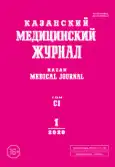A trial of the use of perfusion computed tomography of the brain in combination with transcranial Doppler ultrasonography of blood vessels in patients with acute cerebrovascular accident
- Authors: Valeeva KG1, Perminova SK1, Nazipova AY.1, Kurochkin SV1,2,3, Yakupova AA1,4
-
Affiliations:
- City Clinical Hospital №7
- Kazan (Volga Region) Federal University
- Kazan State Medical Academy
- Kazan State Medical University
- Issue: Vol 101, No 1 (2020)
- Pages: 124-131
- Section: Clinical experiences
- URL: https://journals.rcsi.science/kazanmedj/article/view/20397
- DOI: https://doi.org/10.17816/KMJ2020-124
- ID: 20397
Cite item
Full Text
Abstract
Aim. Assessment of cerebral blood flow in various vascular beds in patients with an acute cerebrovascular accident in the acute period by perfusion computed tomography in combination with transcranial Doppler ultrasonography of cerebral vessels.
Methods. Data was analyzed from perfusion computed tomography of the brain and transcranial Doppler ultrasonography in 35 patients with an acute cerebrovascular accident, based at the vascular centre of the City Clinical Hospital No. 7 of Kazan. The study included 18 (51.4%) women and 17 (48.6%) men who had arrived in the first hours after a vascular accident. When analyzing the stroke subtype, atherothrombotic subtype was determined in 27 (77.1%) patients, cardioembolic subtype in 5 (14.3%) patients, and 3 (8.6%) patients had had a transient ischemic attack.
Results. Perfusion computed tomography is a method that allowed evaluation of the structure of the brain, and blood supply to the anterior cerebral (in 2.9% of the studied patients), middle cerebral (in 62.9% of the studied patients), posterior cerebral (in 11.4% of the studied patients) and vertebral (in 14.2% of the studied patients) arteries of patients with a stroke. The method revealed a zone of “critical” perfusion (ischemic penumbra) by quantitatively processing perfusion indicators in the anterior cerebral blood flow system (decrease in rate and increase in average volume of cerebral blood flow and average transit time) and in the posterior cerebral circulation system (decrease in blood flow and prolongation of transit time) in the bed of the right vertebral artery). The method also aided the construction of perfusion maps. Transcranial Doppler ultrasonography of cerebral vessels revealed breaches in the cerebral circulation: a decrease in the linear velocity of blood flow in the right middle cerebral arterial bed and in the posterior circulatory system of blood flow in the brain, and an increase in the pulsatility index in all the studied vascular beds.
Conclusion. Perfusion computed tomography of the brain in combination with transcranial Doppler ultrasonography is applicable to patients with stroke in various vascular beds, followed by determination of indications for thrombolytic therapy and thrombectomy.
Full Text
##article.viewOnOriginalSite##About the authors
K G Valeeva
City Clinical Hospital №7
Email: svetlana1.lana@yandex.ru
Russian Federation, Kazan, Russia
S K Perminova
City Clinical Hospital №7
Author for correspondence.
Email: svetlana1.lana@yandex.ru
Russian Federation, Kazan, Russia
A Ya Nazipova
City Clinical Hospital №7
Email: svetlana1.lana@yandex.ru
Russian Federation, Kazan, Russia
S V Kurochkin
City Clinical Hospital №7; Kazan (Volga Region) Federal University; Kazan State Medical Academy
Email: svetlana1.lana@yandex.ru
Russian Federation, Kazan, Russia; Kazan, Russia; Kazan, Russia
A A Yakupova
City Clinical Hospital №7; Kazan State Medical University
Email: svetlana1.lana@yandex.ru
Russian Federation, Kazan, Russia; Kazan, Russia;
References
- Gusev E.I., Skvortsova V.I., Stakhovskaya L.V. Epidemiology of stroke in Russia. Zhurnal nevrologii i psikhiatrii. (Prilozhenie «Insul't».) 2003; (8): 4–9. (In Russ.)
- Collection of statistical materials on diseases of the circulatory system. Statistical reference. Moscow: Ministry Of Health Of Russia. 2017; 295 p. (In Russ.)
- Levshakova A.V., Domashenko M.A. Acute cerebrovascular accident: diagnostic and organizational aspects (lecture). Radiologiya — praktika. 2014; (1): 48–57. (In Russ.)
- Morozov I.Yu., Nasnikova I.Yu., Shmyrev V.I. et al. Perfusion computed tomography in the diagnostics of acute cerebral bloodflow disorders. Kremlevskaya meditsina. Klinicheskiy vestnik. 2011; (1): 14–18. (In Russ.)
- Sergeev D.V. Perfusion computed tomography in the diagnosis of acute ischemic stroke. RMZh. 2008; (26): 1758. (In Russ.)
- Shetty S.H., Lev M.H. CT perfusion. In: R.G. Gonzalez, J.A. Hirsch, W.J. Koroshetz et al. (eds.) Acute ischemic stroke. Imaging and intervention. Berlin — Heidelberg: Springer-Verlag. 2006; 87–113. doi: 10.1007/3-540-30810-5_5.
- Camerlingo M., Casto L., Censori B. et al. Transcranial Doppler in acute ischemic stroke of the middle cerebral artery territories. Acta. Neurol. Scand. 1993; 88: 108–111. doi: 10.1111/j.1600-0404.1993.
- Ley-Pozo J., Ringelstein E.B. Noninvasive detection of occlusive disease of the carotid siphon and middle cerebral artery. Ann. Neurol. 1990; 28: 640–647. doi: 10.1002/ana.410280507.
- Ringelstein E.B., von Kummer R., Baron J.-C. Imaging and the early evaluation of stroke. In: Stroke. Emergency management and critical care. T. Steiner, W. Hacke, D.F. Hanley eds. Springer. 1998; 43–60. doi: 10.1002/ana.410280507.
- Miles K.A., Eastwood J.D., Konig M. Multidetector computed tomography in cerebrovascular disease. CT perfusion imaging. Informa, UK. 2007; 175 р.
Supplementary files








